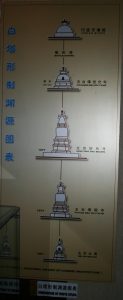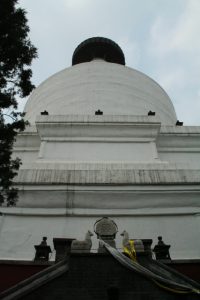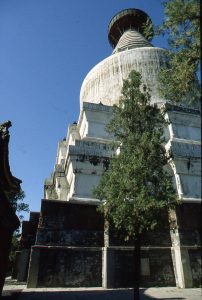Yuan Buddhist Canon Printing
In the early fourteenth century the printing of two separate and massive Yuan editions of the Buddhist canon was finally completed in southeast China. The first was a Tangut edition, the Xixiazang (西夏藏) or Xixia Tripitaka, completed in 1302. The second was the “complete” Chinese edition known as the Jishazang (ji砂藏) or Qisha (or Jisha) Tripitaka. Carving the blocks for the Jishazang had extended over almost a century, between 1231 and 1322.
Both of these editions had been ordered by Khubilai Khan (r.1260-1294) but came to fruition only after his reign, under the supervision of the General Secretary of the Buddhist Clergy in Songjiang, named Guanzhuba (管主巴). Guanzhuba (interpreted as bka’ ‘gyur pa or bka’ rgyud pa in Tibetan) was either Tibetan or of Xixia descent with a Tibetan education. The Xixiazang was printed in 3620 chapters at the Dawanshou (大萬壽) Temple in Hangzhou. It was based on earlier texts in the Xixia script engraved and printed in Xixia before Chinggis Khan destroyed the dynasty in 1227. The Jishazang blocks were carved at the Yansheng Yuan (延聖院) monastery on Jisha Island near Suzhou and Hangzhou. Although work began in the fourth year of the Shaoding reign in the Song dynasty, it was not completed until the second year of the Zhizhi reign of the Yuan. The Yansheng Yuan caught fire in 1258, interrupting the work, which was not resumed until 1299. The blocks finished before the fire seem to have survived. Major work was accomplished between 1300 and 1301, and from 1306-1307 Guanzhuba reconstructed and printed “missing” esoteric sections of the canon for inclusion in this second edition. These sections may have been carved at the same workshop as the Xixiazang in Hangzhou. The text of a vow by Guanzhuba was found in the Mogao cave of Dunhang and dated to the twelfth month of the tenth year of Dade 1307 (another similar but shorter colophon exists in volume 562 of the Yingyin Song Jisha Zangjing 影印宋ji砂藏經). This vow states that Guanzhuba was responsible for carving and printing vast numbers of illustrated Buddhist texts. He further committed to distributing these texts to monasteries, including monasteries in the former Xi xia lands, with great fanfare including offerings, assemblies and teachings. In the Yingyin Song Jisha Zangjing, it also states that Guanzhuba himself donated two hundred silver ingots in the form of a money order, and later three hundred silver ingots for the engraving of the woodblocks.
In addition to the canon, a revised catalogue of the Tripitaka was also published during the twenty-second year of the Zhiyuan reign period, also by order of Khublai Khan. This catalogue, the Zhiyuanlu 至元录 [full name: Zhi Yuan Fa Bao Kan Tong Zhong Lu 至元法宝勘同总录 (A Revised General Catalogue of the Dharma-Treasure up to the Yuan)] is said to have been based on three years of work by several tens of Chinese, Tibetan and Uighur monks, using source material from 1440 books in 5580 volumes. They are also said to have drawn from both Chinese and Tibetan versions of the Tripitaka, as well as the Chinese catalogue Buddhist Sutras Catalogue made in the Kaiyuan Reign Period (Kaiyuan Shijiao Lu) and the Tibetan catalogue kept in the Sakya monastery. This comparative catalogue of Tibetan and Chinese Buddhist canons along with a reconstitution of Sanskrit titles was supported by Khubilai Khan (d. 1294) under the direction of ‘Phags pa and with the assistance of Chinese, Tibetan and Uighur Buddhists. It is preserved in the Chinese Buddhist canon, Taisho vol. 99, number 25, in ten juan.
The printing of the Xixia and Jisha Tripitaka show Tibetan Buddhist influence, with a high level of artistic maturity and technical skill, extending all the way to the seaboard of China during the Mongol Yuan dynasty. The texts also intimate the cooperation of Tibetan artists, Yuan Mongol patrons, and Chinese craftsmen during the long-running, expensive and ambitious project. The Xixia edition reveals the continuing importance of the Xixia people – as well as their models of legitimacy and governance – to the Yuan, and in addition, it can be noted that illustrations from the this canon were later replicated in another edition sponsored by the Yongle emperor of the Ming dynasty. Through the impeccable records kept and the obvious grandeur of the projects, it is clear that the printing of the Buddhist canon in Yuan dynasty China was aimed at making a contribution to the economy as well as building a sense of solidarity among subjects of the state and the legitimacy of the rulers.
Sources:
Patricia Berger. 1994. Preserving the Nation: The Political Uses of Tantric Art in China. In Latter Days of the Law: Images of Chinese Buddhism 85-1850. Lawrence: Spencer Museum of Art, University of Kansas. 89-125.
Heather Karmay (Stoddard). 1975. Early Sino-Tibetan Art. Aris and Phillips.
Rinchen Trashi. 1988. “Tibetan Buddhism and the Yuan Royal Court.” Tibet Studies 1-26.
Françoise Wang-Toutain, “Circulation du savior entre la Chine, la Mongolie, et le Tibet au XVIIe siècle. Le prince Mgon-po skyabs.” Études chinoises, vol XXIV, (2005), 57-111, which cites Huang Hao Zai Beijing de Zangzu wenwu (1993), p. 55.
Entry by Stacey Van Vleet, 1/30/07, with additions by Gray Tuttle 9/22/08
user-1541794279





